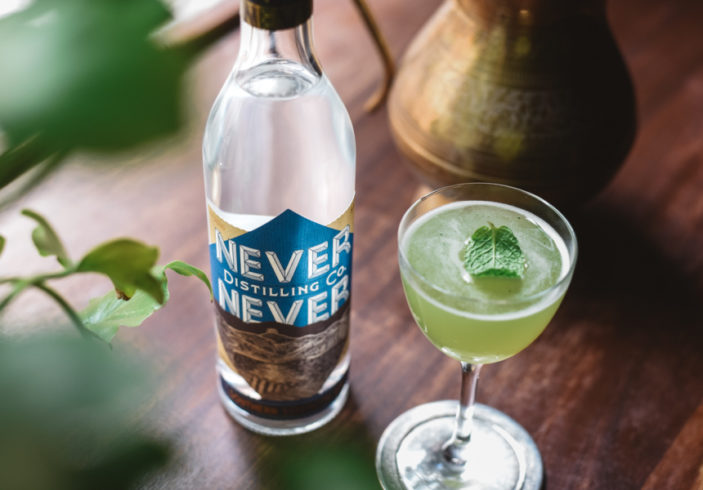
If 2020 has taught us anything, it’s that homemade bars can be just as special as your favourite speakeasy, and a good beverage doesn’t need to be reserved for the pub or restaurant. Anyone is capable of creating and enhancing their mixology skills, whether it’s making a nice cocktail for virtual work drinks or whipping up some aperitifs for all the dinner parties we can finally hold.
The AU Review caught up with Sean Baxter, gin guru and the Brand Director for Adelaide-based World’s Best Gin-winner Never Never Distilling Co. As a mixology expert, Sean has kindly shared his tips and tricks for us to truly master the arcane alcoholic arts and become the cocktail connoisseur we all aspire to be.
Ice is Key
If you’re going to impress your friends and family with your cocktail making capabilities, ensure that you freeze enough H2O. Sean explains that two trays of ice-cubes won’t be enough for that platter of drinks at your next social gathering. “Invest in those ice-cube trays with big compartments that are pre-installed in your freezer. You can also freeze a couple of larger blocks and chip off the ice when you need – it is a bit more labour intensive but it does result in much better ice.”
Fresh ice is also a no-brainer. You don’t want ice that has been sitting in the freezer for a long period of time, especially if it’s lying around some old frozen food whose flavour inevitably ends up infusing into your cocktail.
Pre-making a cocktail batch is a lifesaver. Sean recommends making this ahead of time and freezing the rest away especially if you have guests on the way who want drinks on arrival. “Batching it makes the process a little bit easier – make more than you need, there’s nothing more beautiful than pulling out a premade martini that is good to go.”
If you want to add a special touch for your guests, you can also freeze some glasses before making them a drink which adds that beautiful frosted coating to the glass.
Keep Quality Ingredients
Just like fresh ice, it is imperative to have fresh, quality ingredients. Sean uses seasonal produce and keeps his eyes out for ingredients that are on special at the local supermarket. When time is the enemy, prepping your garnishes beforehand will also be a lifesaver.
Quality mixers are sometimes just as important as the alcohol itself. A tip that Sean gives is to choose ones that create good quality flavours and contain real ingredients. “Another way to guarantee freshness is to use mixers in small bottles or cans rather than buying massive ones so they don’t go flat in the fridge.”
Most people also don’t realise that certain liquors have an expiration date which can quickly alter the flavour and quality of your drink. “Some drinks, like vermouth have an expiration date which will expire very quickly. Just like a bottle of wine oxidises, a bottle of vermouth will as well.” So put drinks like vermouth straight in the fridge as they will have more life in the long run.
Stay True to Measurements
Measuring accurately is one of the most common mistakes people make when concocting a cocktail. They tend to think that adding more alcohol will make a better drink – but that is not the case. “Measuring will always result in the closest representations of the cocktails you’re making.” As long as you’re measuring correctly, whether it be with a large coffee mug or a 30cm egg cup then you can’t go wrong. “If the recipe says equal parts of gin – then make sure it is equal parts.”
Make Do With What You Have
Although Sean is an advocate for cocktail kits and equipment, he is a firm believer that you can get away with using everyday kitchen items. You don’t need to spend a fortune on those fancy equipment when you could easily use kitchen utensils like an old jam jar, whisk, a sieve and still get the same results.
“I use chopsticks to stir my espresso martini, jam jars as shakers and the innerglass tubing of an old coffee plunger – so I don’t need to use a strainer. Anything with a mixing glass or lid works as a cocktail shaker. Get creative.”
Trust Your Resources
There are a lot of cocktail recipes out there and if you’re experimenting with various flavours and ingredients for the first time, it’s vital to get guidance and use resources that are reliable.
“Not all cocktail recipes were born equal. Buy a good cocktail book and use that as your bible. I would recommend ‘Regarding Cocktails’ by Sasha Petraske or ‘A Spot at the Bar’ by Michael Madrusan and Zara Young. Also Difford’s Guide online is a good resource I use regularly. In terms of apps, ‘Bartender’ is very easy to use and is worth the spend.”
But for any aspiring at-home mixologist, Sean believes that simplicity is key. Mastering any three ingredient cocktail, from a G & T, negroni, to a daiquiri will allow you to practice balancing a variety of flavours.
“Simplicity comes first – if you’re at home make sure you learn the core basics first – and learn to balance really simple ingredients. Try making three ingredient cocktails – because they are the core of how to balance a drink, whether you’re using sweetness, bitterness – there are various ingredients out there that form a foundation of those three ingredient styles. It’s also important to have good company, great music and the perfect room temperature but that’s certainly pushing it a bit.”
